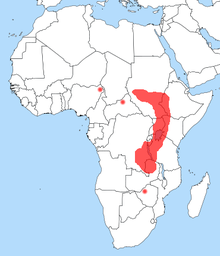Shoebill
| Shoebill | |
|---|---|
 |
|
| Shoebill (Balaeniceps rex) | |
| Scientific classification | |
| Kingdom: | Animalia |
| Phylum: | Chordata |
| Class: | Aves |
| Order: | Pelecaniformes |
| Family: |
Balaenicipitidae Bonaparte, 1853 |
| Genus: |
Balaeniceps Gould, 1850 |
| Species: | B. rex |
| Binomial name | |
|
Balaeniceps rex Gould, 1850 |
|
 |
|
| Shoebill range | |
The shoebill (Balaeniceps rex) also known as whalehead or shoe-billed stork, is a very large stork-like bird. It derives its name from its massive shoe-shaped bill. Although it has a somewhat stork-like overall form and has previously been classified in the order Ciconiiformes, its true affiliations with other living birds is ambiguous. Some authorities now reclassify it with the Pelecaniformes. The adult is mainly grey while the juveniles are browner. It lives in tropical east Africa in large swamps from Sudan to Zambia.
The shoebill was only classified in the 19th century when some skins were brought to Europe. It was not until years later that live specimens reached the scientific community. However, the bird was known to both ancient Egyptians and Arabs. Traditionally allied with the storks (Ciconiiformes), it was retained there in the Sibley-Ahlquist taxonomy which lumped a massive number of unrelated taxa into their "Ciconiiformes". More recently, the shoebill has been considered to be closer to the pelicans (based on anatomical comparisons) or the herons (based on biochemical evidence; Hagey et al., 2002). Microscopic analysis of eggshell structure by Konstantin Mikhailov in 1995 found that the eggshells of shoebills closely resembled those of other Pelecaniformes in having a covering of thick microglobular material over the crystalline shells. A recent DNA study reinforces their membership of the Pelecaniformes.
So far, two fossil relatives of the shoebill have been described: Goliathia from the early Oligocene of Egypt and Paludavis from the Early Miocene of the same country. It has been suggested that the enigmatic African fossil bird Eremopezus was a relative too, but the evidence for that is unconfirmed. All that is known of Eremopezus is that it was a very large, probably flightless bird with a flexible foot, allowing it to handle either vegetation or prey.
...
Wikipedia

